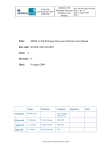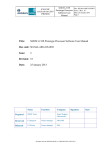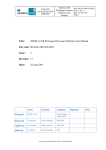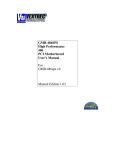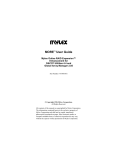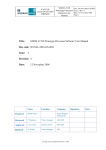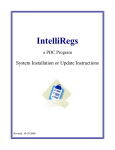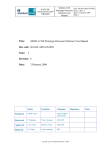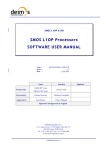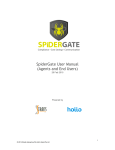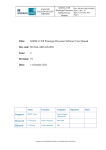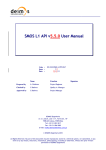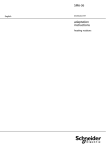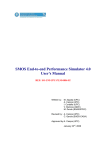Download SO-PL-ARG-GS-0005 Issue
Transcript
ACRI-ST ICM-CSIC LOCEAN/SA/CETP IFREMER Title: Doc: SO-PL-ARG-GS-0005 SMOS L2 OS Product Issue: 1 Rev: 0 Date: 29 September 2008 Verification Plan Page: i SMOS L2 OS Product Verification Plan Doc code: SO-PL-ARG-GS-0005 Issue: 1 Revision: 0 Date: 29 September 2008 Name Function Company Prepared P. Spurgeon Project manager ARGANS Approved S. Lavender Quality control ARGANS Released N. Wright Project manager ESA All rights reserved ARGANS © 2008 Signature Date ACRI-ST ICM-CSIC LOCEAN/SA/CETP IFREMER Doc: SO-PL-ARG-GS-0005 SMOS L2 OS Product Issue: 1 Rev: 0 Date: 29 September 2008 Verification Plan Page: ii Change Record Issue 1 Revision 0 Date 24-07-2008 04-08-2008 29-09-2008 Description First draft Second draft (internal distribution) Version 1.0 delivered to ESA All rights reserved ARGANS © 2008 ACRI-ST ICM-CSIC LOCEAN/SA/CETP IFREMER Doc: SO-PL-ARG-GS-0005 SMOS L2 OS Product Issue: 1 Rev: 0 Date: 29 September 2008 Verification Plan Page: iii Table of Contents 1. INTRODUCTION ............................................................................................................1 1.1. PURPOSE AND SCOPE.........................................................................................................1 1.2. ACRONYMS AND ABBREVIATIONS.....................................................................................1 2. REFERENCE DOCUMENTS .........................................................................................2 3. FIRST LOOK ....................................................................................................................3 3.1. DOES THE L2 OS OPERATIONAL PROCESSOR EXIT WITHOUT ERROR? ................................3 3.2. ANY L2 OS DATA? ............................................................................................................3 4. VERIFYING L1C .............................................................................................................3 4.1. RANGE TESTS ....................................................................................................................3 4.2. BRIGHTNESS TEMPERATURE ..............................................................................................4 4.3. RADIOMETRIC ACCURACY .................................................................................................5 5. VERIFYING AUXILIARY DATA .................................................................................6 5.1. AUX_DGG ......................................................................................................................6 5.2. ECMWF ...........................................................................................................................6 5.3. AUX_DISTAN ................................................................................................................6 5.4. VERIFYING COOEFFICIENTS & LUTS .................................................................................6 6. VERIFYING THE UDP ...................................................................................................7 6.1. SALINITY VALUE AND ACCURACY TEST .............................................................................7 6.2. RETRIEVED GEOPHYSICAL PARAMETER VALUE AND ACCURACY TESTS .............................7 6.3. ICE DETECTION TESTS ........................................................................................................8 6.4. NEAR TO COAST TESTS ......................................................................................................8 6.5. CROSS-CHECKING UDP USING DAP FLAGS & DESCRIPTORS .............................................8 6.6. CROSS-CHECKING UDP USING BREAKPOINTS....................................................................9 6.7. L2 MODEL DIAGNOSTIC TESTS ...........................................................................................9 7. TOOLS FOR VERIFICATION ....................................................................................10 7.1. INSTALLATION VERIFICATION TEST TOOL ........................................................................10 All rights reserved ARGANS © 2008 ACRI-ST ICM-CSIC LOCEAN/SA/CETP IFREMER Doc: SO-PL-ARG-GS-0005 SMOS L2 OS Product Issue: 1 Rev: 0 Date: 29 September 2008 Verification Plan Page: 1 1. Introduction 1.1. Purpose and Scope This is the first draft of a document describing plans for the SMOS in-flight activities to verify the Level 2 Ocean Salinity user data product. It should be read in conjuction with the L2 OS Commissioning Plan [RD.6]. Methodologies are given for verifying the UDP; the DAP is not a user product, so it doesn t need to be verified, but it will be very useful for verifying the UDP. Since the L2 SSS processor relies on specific L1c and auxiliary data, procedures for the verification of these inputs are also given. 1.2. Acronyms and Abbreviations Acronym AD ADF AGDPT BT CDR CEC CFI COTS DAP DDD DPGS ECMWF ESA FAT FPC GNSS GSL GUI ICD IGS L1OP L1PP LUT NRT NRTP OS PA PDPC PDR RD RID Description Applicable Document Auxiliary Data File Auxiliary Geophysical Data Processor Table Brightness Temperature Critical Design Review Calibration and Expertise Centre Customer Furnished Item Commercial Off-The-Shelf Data Analysis Product Detailed Design Document Data Processing Ground Segment European Centre for Medium-Range Weather Forecasts European Space Agency Factory Acceptance Test Fast Processing Center Global Navigation Satellite Systems General Software Library Graphical User Interface Interface Control Document International GNSS Service SMOS Level 1 Operational Processor SMOS Level 1 Prototype Processor Look Up Table Near Real Time Near Real Time Processor Ocean Salinity Product Assurance Payload Data Processing Centre Preliminary Design Review Reference Document Review Item Discrepancy All rights reserved ARGANS © 2008 ACRI-ST ICM-CSIC LOCEAN/SA/CETP IFREMER RPF SMOS SM SOW SPR SRN SUM TBC TBD TEC TN TP TR TRR UDP WEF Doc: SO-PL-ARG-GS-0005 SMOS L2 OS Product Issue: 1 Rev: 0 Date: 29 September 2008 Verification Plan Page: 2 Reference Processing Facility Soil Moisture and Ocean Salinity Soil Moisture Statement Of Work Software Problem Report Software Release Note System User Manual To Be Confirmed To Be Defined Total Electron Count Technical Note Test Plan Test Report Test Readiness Review User Data Product Weight Enumerating Function 2. Reference documents Reference RD.1 Code SO-TN-ARG-GS-0007 RD.2 SO-TN-ARG-GS-0014 RD.3 RD.4 RD.5 RD.6 RD.7 RD.8 RD.9 SO-TN-ARG-GS-0008 SO-TN-ARG-GS-0009 SO-TN-ARG-GS-0010 SO-PL-ARG-GS-0004 SO-PL-ARG-GS-0006 SO-PL-ESA-SYS-5505 SO-MA-ARG-GS-0018 Title SMOS L2 OS Algorithm Theoretical Baseline Document (ATBD) SMOS L2 OS Table Generation Requirements Document (TGRD) SMOS L2 OS Detailed Processing Model (DPM) SMOS L2 OS Input/Output Data Definition (IODD) SMOS L2 OS Parameter Data List (PDL) SMOS L2 OS Commissioning Plan SMOS L2 OS Configuration Management Plan In-Orbit Commissioning Phase Plan SMOS L2 OS Operational Processor Software User Manual All rights reserved ARGANS © 2008 Issue 3.0 3.0 2.4 2.5 2.3 1.0 1.0 1.0 1.2 ACRI-ST ICM-CSIC LOCEAN/SA/CETP IFREMER Doc: SO-PL-ARG-GS-0005 SMOS L2 OS Product Issue: 1 Rev: 0 Date: 29 September 2008 Verification Plan Page: 3 3. First look These first look verification activities are listed in the sequence they should be performed (TBC), starting immediately L1c data becomes available. It is only considered sensible to continue with the next activity once the previous one has been executed successfully. 3.1. Does the L2 OS operational processor exit without error? Check the exit code (see OPSUM [RD.9], section 5). If the error code is > 127 and < 255, no UDP/DAP is produced, so check the error code and product reports. If > 0 and < 128, UDP/DAP may be incomplete, so it may also contain useful diagnostic data. 3.2. Any L2 OS data? Do the L2 OS products contain any data? Check the SPH quality information, GP_Average_Valid_Measurement_percentage, grid point region (latitude & longitude). If no data is generated, check L1c & auxiliary files. If there is a very low percentage of L2 average valid measurements per grid point, look for serious bugs in the software by setting a higher logging level (warn, error, debug) and reviewing log output for problems. If necessary, enable appropriate breakpoints and analyse data as appropriate (see DPM [RD.3] section 9). 4. Verifying L1c 4.1. Range tests Objective: Ensure L1c values used by the L2 OS processor are within expected/valid ranges, using both geophysical criteria and acceptable input ranges for L2 algorithms. Requirements: acceptable ranges for the table of L1c parameters used by L2 OS. L1c parameters used by the L2 OS processor (except those only read from L1c so they can be copied into L2 products, logged, or for processing window selection): Field SPH 5 Parameter Precise_Validity_Start Type string SPH 7 SPH 8 SPH 9 SPH 10 SPH 11 Abs_Orbit_Start Start_Time_ANX_T Abs_Orbit_Stop Stop_Time_ANX_T UTC_at_ANX integer real integer real string SPH 28 SPH 29 SPH 30 Start_Lat Start_Long Stop_Lat real real real Units Acceptable format / range UTC=yyyy-mmddThh:mm:ss.uuuuuu deg deg deg All rights reserved ARGANS © 2008 UTC=yyyy-mmddThh:mm:ss.uuuuuu -90.0 to + 90.0 -180.0 to +180.0 -90.0 to + 90.0 ACRI-ST ICM-CSIC LOCEAN/SA/CETP IFREMER Doc: SO-PL-ARG-GS-0005 SMOS L2 OS Product Issue: 1 Rev: 0 Date: 29 September 2008 Verification Plan SPH 31 SPH 35 SPH 36 2 Stop_Long Radiometric_Accuracy_Scale Pixel_Footprint_Scale Snapshot_Time (3 elements) real integer integer integer 5,6,7 8,9,10 12,13,14,15 16 17,18,19 X,Y,Z_Position X,Y,Z_Velocity quaternions TEC Geomag_F,D,I (3 elements) real real real real real 22 23 26 27 28 Sun_BT Accuracy Grid_Point_ID Grid_Point_Latitude Grid_Point_Longitude Grid_Point_Altitude Flags BT_Value Pixel_Radiometric_Accuracy Incidence_Angle Azimuth_Angle Faraday_Rotation_Angle Geometry_Rotation_Angle SnapshotID Footprint_Axis1,2 real real 31 32 33 34 35 36 37 38 39,40 Page: 4 deg -180.0 to +180.0 K >0 km >0 days, secs, uSecs m m/s tecu nT, deg, deg K K deg deg m real real real real real real integer real -90 to + 90 -180 to +180 K K deg deg deg deg km TBD: why are the L1c Quality_Information flags never used in L2? Dependencies: Pass/fail criteria: specify pass if all elements within specified ranges, else fail. Methodology: 4.2. Brightness temperature Objective: ensure L1c Tb s have acceptable values. Requirements: L1c product for specific regions (TBD) known to be far from coast and other sources of error (eg high wind, ice), where reasonable values of Tb can be expected. Pass/fail criteria: less than 5% of gridpoints inside selected region with (SSS < Tg_SSS_min or > Tg_SSS_max), and less than 5% detected as outliers with nsig > Tg_sigma_max? All rights reserved ARGANS © 2008 ACRI-ST ICM-CSIC LOCEAN/SA/CETP IFREMER Doc: SO-PL-ARG-GS-0005 SMOS L2 OS Product Issue: 1 Rev: 0 Date: 29 September 2008 Verification Plan Page: 5 Methodology: Fm_out_of_range is set in the DAP for each gridpoint measurement if the difference between L1c Tb and the default forward model Tb is outside an acceptable range (Tm_out_of_range, set in AUX_CNFOSD/F) see DPM PRP_8_2-1. Sum Fm_out_of_range & Dg_num_meas_l1c for all gridpoint measurements inside the specified regions. Fm_outlier is set in the DAP for each gridpoint measurement if the difference between the antenna frame L1c Tb and the default forward model Tb minus the median (Tb_meas-Tb_model) is greater than nsig sigma (set in AUX_CNFOSD/F currently 5 sigma!) see DPM PRP_8_2-8. Sum Dg_num_outliers & Dg_num_meas_l1c for all gridpoints inside the specified regions. Could perform analysis on Fm_outlier by setting breakpoint BP_PRP_8_2-2, or by analysing DAP using SMOS Analyser or other tool? 4.3. Radiometric accuracy Each L1c snapshot has a pair of fields recording the radiometric accuracy temperature value at boresight: the first value is the pure polarisation value, the second is the cross-polarisation value. The second element is only used to indicate the boresight accuracy for full polarisation snapshots, and is to 0 in all other cases. It would be possible to add checks and output data in DAP if required/specified. Each L1c measurment has a pixel radiometric accuracy value for the brightness temperature extracted in the direction of the pixel. This value is scaled a radiometric accuracy scale factor given in the L1c SPH. The pixel radiometric accuracy is used in L2 OS to help determine outliers (see DPM PRP_8_2), to compute Stokes 1 (DPM MAP_5-1), and in the iterative scheme (DPM MAP_3_1-5), but is not otherwise used or put into L2 products - it would be possible to add checks and output data in DAP if required/specified. Or a breakpoint could be added after the calculation of the variance-covariance matrix in MAP_3_1-5: breakpoint BP_MAP_3_1-1 outputs the inverse of the variance-covariance matrix maybe this can be used to check radiometric accuracy? All rights reserved ARGANS © 2008 ACRI-ST ICM-CSIC LOCEAN/SA/CETP IFREMER Doc: SO-PL-ARG-GS-0005 SMOS L2 OS Product Issue: 1 Rev: 0 Date: 29 September 2008 Verification Plan Page: 6 5. Verifying auxiliary data Installation verification test (tool TBC) should include versions and checksum(s). 5.1. AUX_DGG Could be cross-verified with grid point IDs, latitude and longitude in other products (L1c, ECMWF...). Is this necessary? We could verify values are in the expected ranges. 5.2. ECMWF Fg_ctrl_ECMWF is cleared (set = ecmwf data ok) for each gridpoint per roughness model if one or more of the 28 ECMWF data items required for L2 OS processing is missing (expected or unexpected ie -99999 or -99998). No other range checks are implemented at present is this reasonable? Additional flags could be added to the DAP if necessary, or breakpoints added. Otherwise it is necessary to cross-check the Fg_ctrl_ECMWF with the input file a tool could be written to do this. Alternatively BP_PRP_3_1-5 could be analysed, since it contains all the ECMWF data. Could also use out-of-LUT-range flags. Is it reasonable to forecast during the first month of the mission to check ECMWF data using climatology? Percentage of valid data in the zone could be calculated. Proper co-location of Tb and auxiliary data (both in space and time) should be checked? Is the Aux Data pre-processor in charge of that? 5.3. AUX_DISTAN Visually verify distance to coast by superimposing on a map. 5.4. Verifying cooefficients & LUTs First pass checking can done by checking DAP out-of-LUT flags (per model per gridpoint). Too many gridpoints returning out-of-range indicate a problem! For example, fg_OoR_Gam2_Psi seems to be set very frequently in forward model 1. All rights reserved ARGANS © 2008 ACRI-ST ICM-CSIC LOCEAN/SA/CETP IFREMER Doc: SO-PL-ARG-GS-0005 SMOS L2 OS Product Issue: 1 Rev: 0 Date: 29 September 2008 Verification Plan Page: 7 6. Verifying the UDP 6.1. Salinity value and accuracy test Objective: ensure salinity is retrieved for the majority of the ocean within an acceptable range and accuracy. Requirements: Definition of ocean areas, acceptable ranges (maybe by area/region), and associated acceptable salinity sigma errors (maybe different for each of the 3 models). Pass/fail criteria: Methodology: Use Fg_ctrl_range & Fg_ctrl_sigma flags to ensure salinity is retrieved for the majority of the ocean within an acceptable range (currently 30-40 psu) and accuracy (currently < 5). (NB Ignore the A_card test result bits in Control_Flags_4 it s not expected to be in the SSS range). Might need to remove some measurements according to other criteria first (eg too close to land, too many outliers...). And/or, use Fg_sc_high_SSS & Fg_sc_low_SSS from UDP to ensure expected SSS range is retrieved within each area: these 2 flags classify SSS as low, below medium, above medium, or high, with default thresholds at 31, 34 & 37 psu (set in AUX_CNFOSD/F). 6.2. Retrieved geophysical parameter value and accuracy tests Objective: ensure geophysical parameters (other than salinity) are retrieved for the majority of the ocean within an acceptable range and accuracy. Requirements: Definition of ocean areas, acceptable geophysical parameter ranges (maybe by area/region) and associated accuracy (maximum sigma). Pass/fail criteria: Methodology: Scan UDP for acceptable values of retrieved geophysical parameters: A_card, WS, SST, Tb_42.5H, Tb_42.5V, Tb_42.5X, Tb_42.5Y and associated sigma values. Use Fg_sc_high_SST & Fg_sc_low_SST from UDP to ensure expected SST range is retrieved within each area: these 2 flags classify SST as low, below medium, above medium, or high, with default thresholds at 283, 291 & 298 K (set in AUX_CNFOSD/F). Use Fg_sc_high_wind & Fg_sc_low_wind from UDP to ensure expected wind speed range is retrieved within each area: these 2 flags classify wind as low, below medium, above medium, or high, with default thresholds at 3, 7 & 12 m.s-1 (set in AUX_CNFOSD/F). Could also compare with ECMWF data for the same grid points. All rights reserved ARGANS © 2008 ACRI-ST ICM-CSIC LOCEAN/SA/CETP IFREMER Doc: SO-PL-ARG-GS-0005 SMOS L2 OS Product Issue: 1 Rev: 0 Date: 29 September 2008 Verification Plan Page: 8 6.3. Ice detection tests Objective: ensure ice is detected where it should be, and not detected when it is unlikely to occur. Requirements: Definition of ocean areas with high and low probability for ice. Pass/fail criteria: Methodology: check each of the following, & cross-check for consistency. UDP contains several flags for ice detection, per model per gridpoint: Fg_sc_in_clim_ice, set if the gridpoint is inside sea ice extent according to the monthly climatology ice map (DPM PRP_3_1-5). The ice extent is defined in AUX_DISTAN per gridpoint by a monthly bit mask. Fg_sc_ice, set if ice concentration % > Tg_ice_concentration (default 30%) (DPM PRP_7_1-1), set by testing the sea ice concentration from ECMWF against the threshold. Fg_sc_suspect_ice, set if Dg_Suspect_ice > Tg_suspect_ice (default 50%) & Tg_low_SST_ice (default 275 K). This test is done at the antenna level (DPM PRP_7_2-5). NB Fg_sc_suspect_ice & Fg_sc_ice are the same for all 4 models: only model 0 is used/set in the UDP. Fg_sc_ice_Acard set if ice flagged by cardioid model: A_card > Tg_Acard_ice and abs(latitude) > Tg_lat_ice_Acard and SST > Tg_SST_ice_Acard (DPM POP_1-16). DAP contains Fm_suspect_ice, set if Tb > Tb flat sea + Tm_DT_ice (DPM PRP_7_2-4). An example of ice detection test could be: If Fg_sc_ice.true and Fg_sc_suspect_ice.true, then Fg_sc_in_clim_ice should also be true, at least for 50% (?) of the cases. Should be: AND Fg _ sc _ ice, Fg _ suspect _ ice, Fg _ sc _ in _ clim _ ice AND Fg _ sc _ ice, Fg _ suspect _ ice 6.4. Near to coast tests 6.5. Cross-checking UDP using DAP flags & descriptors All rights reserved ARGANS © 2008 0 .5 ACRI-ST ICM-CSIC LOCEAN/SA/CETP IFREMER Doc: SO-PL-ARG-GS-0005 SMOS L2 OS Product Issue: 1 Rev: 0 Date: 29 September 2008 Verification Plan Page: 9 6.6. Cross-checking UDP using breakpoints 6.7. L2 model diagnostic tests Objective: Determine which models are working, under which conditions. Requirements: new quality information flags from SPH. Pass/fail criteria: Methodology: The following flags could be checked as L2 model diagnostic test: o o o o o o o o Fg_ctrl_range_X (false = reasonable value of the retrieved SSS) Fg_ctrl_sigma_X (false = reasonable accuracy of the retrieved SSS) Fg_ctrl_chi2_X (true = poor fit) Fg_ctrl_chi2_PX (true = poor fit) Fg_ctrl_quality_SSSX (true = poor quality) Fg_ctrl_read_maxiterX (true = max. iteration reached during the minimization) Fg_ctrl_marq_X (true = Marquardt increment too big) If OR Fg _ ... 0 the retrieval is good, the test could be: OR Fg _ ... Fg _ ctrl _ valid o o o 0.05 Dg_quality_SSSX (the lower the better). Retrieved SSS from one overpass could be compared with the one from the previous one (or with one of the previous ones with the same orbital characteristics). The median of the difference between the two retrieved SSS should not be high. Zones far from coast and from fronts should be taken into account. Is this commissioning? Apart from SSS, SST and WS retrieval accuracy could be analyzed too. The test could be on the variable paramX_sigma_MX (in the DAP). Should the Measurements Discrimination be repeated through an independent tool for safety (to verify that L2 flags are consistent with L1 flags)? All rights reserved ARGANS © 2008 ACRI-ST ICM-CSIC LOCEAN/SA/CETP IFREMER Doc: SO-PL-ARG-GS-0005 SMOS L2 OS Product Issue: 1 Rev: 0 Date: 29 September 2008 Verification Plan 7. Tools for Verification 7.1. Installation verification test tool Checks installed components, versions and checksum(s). All rights reserved ARGANS © 2008 Page: 10













